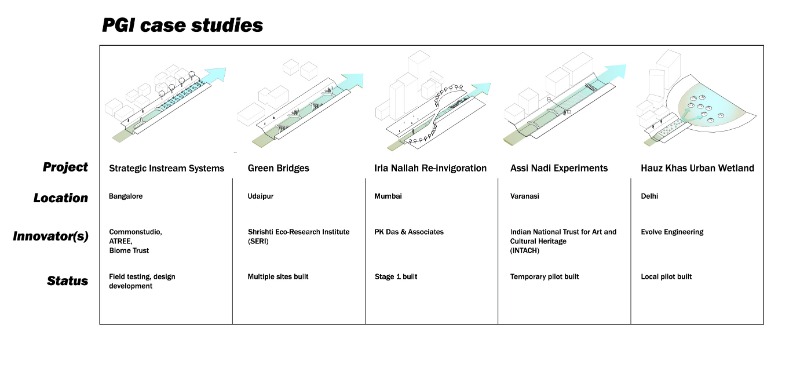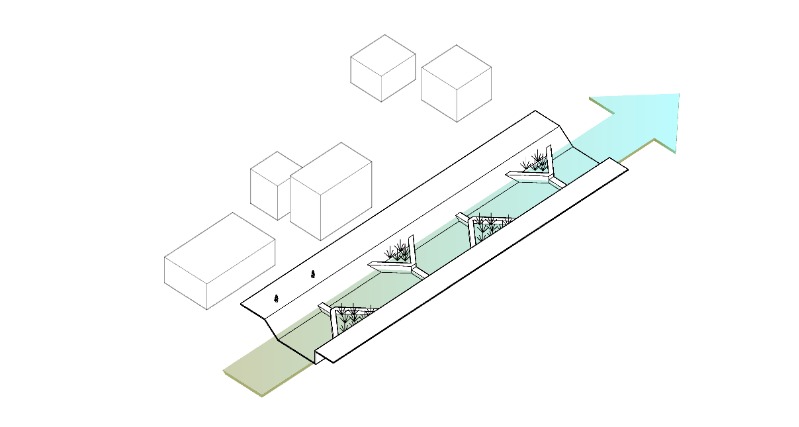- Forum
- categories
- Sanitation systems
- Various topics related to sanitation systems
- Sewer systems and stormwater drainage
- Asking for your input on a research project (in-stream wastewater innovations in India)
Asking for your input on a research project (in-stream wastewater innovations in India)
4430 views
- danielphillips
-
 Topic Author
Topic Author- Daniel Phillips is an urban landscape ecologist and creative practitioner. Assistant Professor or Landscape Architecture at Texas Tech University, Co-founder of Commonstudio (thecommonstudio.com). Current projects span many disciplines, contexts and cultures.
Re: Asking for your input on a research project (in-stream wastewater innovations in India)
The second didn't attach?! Trying again
This attachment is hidden for guests.
Please log in or register to see it.
Please log in or register to see it.
Daniel Phillips, PhD, FAAR
Assistant Professor, Texas Tech University
Founder, COMMONStudio (www.thecommonstudio.com)
Twitter: @thecommonstudio
424-209-2650
This email address is being protected from spambots. You need JavaScript enabled to view it.
Assistant Professor, Texas Tech University
Founder, COMMONStudio (www.thecommonstudio.com)
Twitter: @thecommonstudio
424-209-2650
This email address is being protected from spambots. You need JavaScript enabled to view it.
This message has an attachment file.
Please log in or register to see it.
Please Log in to join the conversation.
You need to login to reply- danielphillips
-
 Topic Author
Topic Author- Daniel Phillips is an urban landscape ecologist and creative practitioner. Assistant Professor or Landscape Architecture at Texas Tech University, Co-founder of Commonstudio (thecommonstudio.com). Current projects span many disciplines, contexts and cultures.
Re: Asking for your input on a research project (in-stream wastewater innovations in India)
Hello all,
About a year ago, I solicited the SusAnA community to respond to our survey about in-stream Nature-based Solutions to stormwater/wastewater contamination (see original post HERE ). I'm happy to follow up here to share 2 related peer-reviewed papers that arose in part from that effort! The first is a paper published in Urban Water Journal:
Informal diffusion of green infrastructure innovations in Indian megacities: perspectives from innovators and potential future adopters
ABSTRACT: Five early-stage sustainable urban water management innovations in India are examined utilizing diffusion of Innovations theory. Cases are described using grey literature, surveys, and qualitative insights derived from interviews with innovators (N = 5). Potential future adopters (PFA’s) were also surveyed (N = 31), and their attitudes toward adoption is discussed. We identify alignments and misalignments between the goals, perceptions, adoption attitudes, and modes of communication between innovators and PFA’s. Innovators and PFA’s were largely aligned in their assessment of two innovation characteristics considered ‘most important’ (namely relative advantage and compatibility), but not aligned regarding simplicity (rated ‘most important’) or other ‘moderately important’ to ‘less important’ innovation char- acteristics (trialability, observability, and reinvention). We identify the role of communication channels between innovators and PFA’s, and suggest that innovators might work to better emphasize the simplicity of their approaches to maximize the likelihood of adoption. Finally, we identify opportunities for future research in this under-studied domain.
www.tandfonline.com/doi/abs/10.1080/1573...7?journalCode=nurw20
The second was published in Landscape and Urban Planning, entitled:
Assessing catchment-scale performance of in-stream Provisional Green Infrastructure interventions for Dry Weather Flows
ABSTRACT: Provisional Green Infrastructure (PGI) refers to a range of instream intervention strategies that are currently being developed and deployed by non-state actors in the context of Indian megacities to supplement inefficient operation of grey infrastructures while providing localized multi-functional benefits. This study addresses how variations in the location and configuration of PGI interventions at the watershed catchment scale impact their cumulative performance in terms of contaminant removal efficiency, cost, and public accessibility using a SWMM-based TOPSIS approach. We consider 4 PGI upscaling scenarios in a 5.4 sq. km. watershed in the periphery of Bangalore, India: S1) Downgradient dispersed S2) Downgradient centralized S3) Upgradient dispersed S4) Upgradient centralized. Additionally, S0 was employed as a ‘control’ scenario (in which no interventions are made), and S5 assumed the construction of a conventional wastewater treatment plant (WWTP). Total Suspended Solids (TSS) removal efficiencies ranged from 53% to 97% and performed better in upgradient locations. Total Phosphorus (TP) removal ranged from 59% to 90% and were less sensitive to catchment location, but were substantially improved in scenarios with dispersed configurations. Costs associated with PGI upscaling (4.2–6.3 million INR) were substantially lower than for S5 (37.5 million INR), and accessibility scores were considerably larger in upgradient PGI scenarios. Results suggest dispersed configurations of PGI interventions are optimal wherever such an approach is feasible. In cases where dispersed configurations prove unfeasible, centralized configurations should be placed preferentially in upgradient locations in the watershed, and in locations with higher pollutant concentrations and lower flow rates such as channels with shallower slopes. Authors emphasize PGI should not be viewed as a functional replacement for conventional wastewater treatment infrastructures, but rather as a supplementary stop-gap function in contexts where functional separation of wastewater and stormwater are unlikely to occur, or where existing large scale WWTP’s operate below their designed capacity.
www.sciencedirect.com/science/article/pi...622000974?via%3Dihub
I have attached full texts here as well.
About a year ago, I solicited the SusAnA community to respond to our survey about in-stream Nature-based Solutions to stormwater/wastewater contamination (see original post HERE ). I'm happy to follow up here to share 2 related peer-reviewed papers that arose in part from that effort! The first is a paper published in Urban Water Journal:
Informal diffusion of green infrastructure innovations in Indian megacities: perspectives from innovators and potential future adopters
ABSTRACT: Five early-stage sustainable urban water management innovations in India are examined utilizing diffusion of Innovations theory. Cases are described using grey literature, surveys, and qualitative insights derived from interviews with innovators (N = 5). Potential future adopters (PFA’s) were also surveyed (N = 31), and their attitudes toward adoption is discussed. We identify alignments and misalignments between the goals, perceptions, adoption attitudes, and modes of communication between innovators and PFA’s. Innovators and PFA’s were largely aligned in their assessment of two innovation characteristics considered ‘most important’ (namely relative advantage and compatibility), but not aligned regarding simplicity (rated ‘most important’) or other ‘moderately important’ to ‘less important’ innovation char- acteristics (trialability, observability, and reinvention). We identify the role of communication channels between innovators and PFA’s, and suggest that innovators might work to better emphasize the simplicity of their approaches to maximize the likelihood of adoption. Finally, we identify opportunities for future research in this under-studied domain.
www.tandfonline.com/doi/abs/10.1080/1573...7?journalCode=nurw20
The second was published in Landscape and Urban Planning, entitled:
Assessing catchment-scale performance of in-stream Provisional Green Infrastructure interventions for Dry Weather Flows
ABSTRACT: Provisional Green Infrastructure (PGI) refers to a range of instream intervention strategies that are currently being developed and deployed by non-state actors in the context of Indian megacities to supplement inefficient operation of grey infrastructures while providing localized multi-functional benefits. This study addresses how variations in the location and configuration of PGI interventions at the watershed catchment scale impact their cumulative performance in terms of contaminant removal efficiency, cost, and public accessibility using a SWMM-based TOPSIS approach. We consider 4 PGI upscaling scenarios in a 5.4 sq. km. watershed in the periphery of Bangalore, India: S1) Downgradient dispersed S2) Downgradient centralized S3) Upgradient dispersed S4) Upgradient centralized. Additionally, S0 was employed as a ‘control’ scenario (in which no interventions are made), and S5 assumed the construction of a conventional wastewater treatment plant (WWTP). Total Suspended Solids (TSS) removal efficiencies ranged from 53% to 97% and performed better in upgradient locations. Total Phosphorus (TP) removal ranged from 59% to 90% and were less sensitive to catchment location, but were substantially improved in scenarios with dispersed configurations. Costs associated with PGI upscaling (4.2–6.3 million INR) were substantially lower than for S5 (37.5 million INR), and accessibility scores were considerably larger in upgradient PGI scenarios. Results suggest dispersed configurations of PGI interventions are optimal wherever such an approach is feasible. In cases where dispersed configurations prove unfeasible, centralized configurations should be placed preferentially in upgradient locations in the watershed, and in locations with higher pollutant concentrations and lower flow rates such as channels with shallower slopes. Authors emphasize PGI should not be viewed as a functional replacement for conventional wastewater treatment infrastructures, but rather as a supplementary stop-gap function in contexts where functional separation of wastewater and stormwater are unlikely to occur, or where existing large scale WWTP’s operate below their designed capacity.
www.sciencedirect.com/science/article/pi...622000974?via%3Dihub
I have attached full texts here as well.
Daniel Phillips, PhD, FAAR
Assistant Professor, Texas Tech University
Founder, COMMONStudio (www.thecommonstudio.com)
Twitter: @thecommonstudio
424-209-2650
This email address is being protected from spambots. You need JavaScript enabled to view it.
Assistant Professor, Texas Tech University
Founder, COMMONStudio (www.thecommonstudio.com)
Twitter: @thecommonstudio
424-209-2650
This email address is being protected from spambots. You need JavaScript enabled to view it.
This message has an attachment file.
Please log in or register to see it.
Please Log in to join the conversation.
You need to login to reply- danielphillips
-
 Topic Author
Topic Author- Daniel Phillips is an urban landscape ecologist and creative practitioner. Assistant Professor or Landscape Architecture at Texas Tech University, Co-founder of Commonstudio (thecommonstudio.com). Current projects span many disciplines, contexts and cultures.
Re: Asking for your input on a research project (in-stream wastewater innovations in India)
Hello Paresh and thank you for your response/feedback. We chose the cases based on their specific relationship to the nallah itself. Not many innovators are doing this type of work so there aren't a huge list to draw cases from. These 5 therefore represent variations on the theme of in-situ (in-stream) treatment approaches that don't require any electricity or complex technologies for their function.
We believe they have a supplementary role to play in sustainable urban water management practices (IE can be deployed in tandem with conventional STP's, etc. to close capacity gaps and create other forms of environmental benefits in local communities). Happy to answer any questions you or anyone else may have. As a reminder, the survey is still live and we would love to get more SUSANA participants if you are interested! Please find it here:
umich.qualtrics.com/jfe/form/SV_3xeTntpx1iyzVvo
As for the notion of "innovation" we use Everett Roger's "Diffusion of Innovations" framework as a reference. An innovation is defined as “an idea, thing, procedure, or system that is perceived to be new by whomever is adopting it” (Rogers, 2003, p. 10) . Rogers defines five key characteristics of the innovation itself which influence its success and rate of adoption over time. These characteristics include relative advantage, compatibility, simplicity, trialability and observability. Later, reinvention was proposed by other scholars as a sixth characteristic, defined as “the degree to which an innovation is changed or modified by a user in the process of its adoption and implementation” (Rogers, 1995, p. 17) . This simple framework of innovation characteristics (Table 1) can be applied to a given innovation to assess the speed with which it might be diffused or upscaled. DOI theory states that as each of these characteristics increase, so too does the rate of adoption (with the exception of complexity, for which a decrease in complexity results in an increase in adoption).
So we see PGI innovations in the domain of Sustainable Urban Water Management (SUWM), and are trying to understand how these characteristics apply in this case.
We believe they have a supplementary role to play in sustainable urban water management practices (IE can be deployed in tandem with conventional STP's, etc. to close capacity gaps and create other forms of environmental benefits in local communities). Happy to answer any questions you or anyone else may have. As a reminder, the survey is still live and we would love to get more SUSANA participants if you are interested! Please find it here:
umich.qualtrics.com/jfe/form/SV_3xeTntpx1iyzVvo
As for the notion of "innovation" we use Everett Roger's "Diffusion of Innovations" framework as a reference. An innovation is defined as “an idea, thing, procedure, or system that is perceived to be new by whomever is adopting it” (Rogers, 2003, p. 10) . Rogers defines five key characteristics of the innovation itself which influence its success and rate of adoption over time. These characteristics include relative advantage, compatibility, simplicity, trialability and observability. Later, reinvention was proposed by other scholars as a sixth characteristic, defined as “the degree to which an innovation is changed or modified by a user in the process of its adoption and implementation” (Rogers, 1995, p. 17) . This simple framework of innovation characteristics (Table 1) can be applied to a given innovation to assess the speed with which it might be diffused or upscaled. DOI theory states that as each of these characteristics increase, so too does the rate of adoption (with the exception of complexity, for which a decrease in complexity results in an increase in adoption).
So we see PGI innovations in the domain of Sustainable Urban Water Management (SUWM), and are trying to understand how these characteristics apply in this case.
Daniel Phillips, PhD, FAAR
Assistant Professor, Texas Tech University
Founder, COMMONStudio (www.thecommonstudio.com)
Twitter: @thecommonstudio
424-209-2650
This email address is being protected from spambots. You need JavaScript enabled to view it.
Assistant Professor, Texas Tech University
Founder, COMMONStudio (www.thecommonstudio.com)
Twitter: @thecommonstudio
424-209-2650
This email address is being protected from spambots. You need JavaScript enabled to view it.
Attachments:
-
 Precedents...d-01.jpg
(Filesize: 69KB)
Precedents...d-01.jpg
(Filesize: 69KB)
The following user(s) like this post: paresh
Please Log in to join the conversation.
You need to login to reply- paresh
-

- Moderator
- Budding WASH researcher, especially interested in governance, public policy, finance, politics and social justice. Architect, Urban & Regional planner by training, Ex. C-WAS, India.I am a patient person :)
Less- Posts: 370
- Karma: 7
- Likes received: 140
Re: Asking for your input on a research project (in-stream wastewater innovations in India)
Hi Daniel,
This is a very informative survey and thanks for providing a link to your publication, I look forward to getting to know more about the cases included in the survey.
I am curious regarding the choice of the cases presented here (not sure if your publication already explains this). Did you have a longer list of projects from which these were selected? What were the criteria for choosing these in such a scenario?
Also, how are you defining 'innovation'? And what type of innovation do you consider these projects to be?
Regards
paresh
This is a very informative survey and thanks for providing a link to your publication, I look forward to getting to know more about the cases included in the survey.
I am curious regarding the choice of the cases presented here (not sure if your publication already explains this). Did you have a longer list of projects from which these were selected? What were the criteria for choosing these in such a scenario?
Also, how are you defining 'innovation'? And what type of innovation do you consider these projects to be?
Regards
paresh
Paresh Chhajed-Picha
Moderator, SuSanA forum
Project Manager at ADCPS
Indian Institute of Technology - Bombay, India
Moderator, SuSanA forum
Project Manager at ADCPS
Indian Institute of Technology - Bombay, India
Please Log in to join the conversation.
You need to login to reply- danielphillips
-
 Topic Author
Topic Author- Daniel Phillips is an urban landscape ecologist and creative practitioner. Assistant Professor or Landscape Architecture at Texas Tech University, Co-founder of Commonstudio (thecommonstudio.com). Current projects span many disciplines, contexts and cultures.
Re: Asking for your input on a research project (in-stream wastewater innovations in India)
Thank you Elizabeth!
Very helpful to provide an overview right here in the forum
Reminder that the survey is still live and seeking participants, please find it here: umich.qualtrics.com/jfe/form/SV_3xeTntpx1iyzVvo
Very helpful to provide an overview right here in the forum
Reminder that the survey is still live and seeking participants, please find it here: umich.qualtrics.com/jfe/form/SV_3xeTntpx1iyzVvo
Daniel Phillips, PhD, FAAR
Assistant Professor, Texas Tech University
Founder, COMMONStudio (www.thecommonstudio.com)
Twitter: @thecommonstudio
424-209-2650
This email address is being protected from spambots. You need JavaScript enabled to view it.
Assistant Professor, Texas Tech University
Founder, COMMONStudio (www.thecommonstudio.com)
Twitter: @thecommonstudio
424-209-2650
This email address is being protected from spambots. You need JavaScript enabled to view it.
Please Log in to join the conversation.
You need to login to reply- Elisabeth
-
- Moderator
- Freelance consultant since 2012 (former roles: program manager at GIZ and SuSanA secretariat, lecturer, process engineer for wastewater treatment plants)
Less- Posts: 3372
- Karma: 54
- Likes received: 931
Re: Asking for your input on a research project (in-stream wastewater innovations in India)
Hi Daniel,
I am copying below the abstract of your paper so that this thread can be found with keyword searches and to make more people aware of the "provisional green infrastructure" (PGI) approach.
++++++++++++++
Provisional green infrastructure: transdisciplinary
approaches to address contamination in urban streams
Priyanka Jamwal, Durba Biswas and Daniel Phillips
ABSTRACT
Surface water contamination has emerged as an area of major concern in rapidly growing cities in
the Global South, including and especially in the Indian megacity context. We argue here that nallahs
(open drainage channels in Indian megacities) should be more widely recognized as a potential locus
of intervention. These combined stormwater and wastewater networks offer opportunities for
flexible, frugal and inclusive retrofits to improve surface and groundwater quality. We propose and
define the concept of provisional green infrastructure (PGI) as a speculative innovation typology
describing in-stream interventions. We argue that PGI should be employed as a shared boundary
concept guiding transdisciplinary action and research within the highly unpredictable, space-
constrained, and contaminated watersheds. Citing case studies throughout the region and ongoing
research in the city of Bangalore, we demonstrate in-stream modifications may be capable of
achieving significant improvement in the quality of urban wastewater and may play a complementary
role in closing persistent capacity gaps in the operation of both centralized and decentralized
treatment practices within megacities. Anticipating the larger diffusion of PGI practices across the
region by various early adopters and non-state actors, we suggest a cogent research agenda focused
on identifying various generalizable ‘upscaling’opportunities for deploying in-stream interventions
across various organizational and spatial domains.
Key words |green infrastructure, megacities, stormwater drains, typology, wastewater treatment,
water quality
HIGHLIGHTS
•Provisional green infrastructure (PGI) is introduced for the first time as a relevant
innovation typology describing a range of sustainable urban water management
research and practices throughout the context of the Global South.
•Discusses emerging precedents for PGI intervention in megacities across India.
•Provides a framework for assessing future organizational and spatial ‘up-scaling’
efforts
Regards,
Elisabeth
I am copying below the abstract of your paper so that this thread can be found with keyword searches and to make more people aware of the "provisional green infrastructure" (PGI) approach.
++++++++++++++
Provisional green infrastructure: transdisciplinary
approaches to address contamination in urban streams
Priyanka Jamwal, Durba Biswas and Daniel Phillips
ABSTRACT
Surface water contamination has emerged as an area of major concern in rapidly growing cities in
the Global South, including and especially in the Indian megacity context. We argue here that nallahs
(open drainage channels in Indian megacities) should be more widely recognized as a potential locus
of intervention. These combined stormwater and wastewater networks offer opportunities for
flexible, frugal and inclusive retrofits to improve surface and groundwater quality. We propose and
define the concept of provisional green infrastructure (PGI) as a speculative innovation typology
describing in-stream interventions. We argue that PGI should be employed as a shared boundary
concept guiding transdisciplinary action and research within the highly unpredictable, space-
constrained, and contaminated watersheds. Citing case studies throughout the region and ongoing
research in the city of Bangalore, we demonstrate in-stream modifications may be capable of
achieving significant improvement in the quality of urban wastewater and may play a complementary
role in closing persistent capacity gaps in the operation of both centralized and decentralized
treatment practices within megacities. Anticipating the larger diffusion of PGI practices across the
region by various early adopters and non-state actors, we suggest a cogent research agenda focused
on identifying various generalizable ‘upscaling’opportunities for deploying in-stream interventions
across various organizational and spatial domains.
Key words |green infrastructure, megacities, stormwater drains, typology, wastewater treatment,
water quality
HIGHLIGHTS
•Provisional green infrastructure (PGI) is introduced for the first time as a relevant
innovation typology describing a range of sustainable urban water management
research and practices throughout the context of the Global South.
•Discusses emerging precedents for PGI intervention in megacities across India.
•Provides a framework for assessing future organizational and spatial ‘up-scaling’
efforts
Regards,
Elisabeth
Dr. Elisabeth von Muench
Freelance consultant on environmental and climate projects
Freelance consultant on environmental and climate projects
Please Log in to join the conversation.
You need to login to reply- danielphillips
-
 Topic Author
Topic Author- Daniel Phillips is an urban landscape ecologist and creative practitioner. Assistant Professor or Landscape Architecture at Texas Tech University, Co-founder of Commonstudio (thecommonstudio.com). Current projects span many disciplines, contexts and cultures.
Re: Asking for your input on a research project (in-stream wastewater innovations in India)
Thank you Elizabeth,
This should have read "Early March". Anyone who may be interested in hearing more about Provisional Green Infrastructure in general can download a recent publication via Researchgate: CLICK HERE
Daniel
This should have read "Early March". Anyone who may be interested in hearing more about Provisional Green Infrastructure in general can download a recent publication via Researchgate: CLICK HERE
Daniel
Daniel Phillips, PhD, FAAR
Assistant Professor, Texas Tech University
Founder, COMMONStudio (www.thecommonstudio.com)
Twitter: @thecommonstudio
424-209-2650
This email address is being protected from spambots. You need JavaScript enabled to view it.
Assistant Professor, Texas Tech University
Founder, COMMONStudio (www.thecommonstudio.com)
Twitter: @thecommonstudio
424-209-2650
This email address is being protected from spambots. You need JavaScript enabled to view it.
Please Log in to join the conversation.
You need to login to reply- Elisabeth
-
- Moderator
- Freelance consultant since 2012 (former roles: program manager at GIZ and SuSanA secretariat, lecturer, process engineer for wastewater treatment plants)
Less- Posts: 3372
- Karma: 54
- Likes received: 931
Re: Asking for your input on a research project (in-stream wastewater innovations in India)
Hi Daniel,
Welcome to the SuSanA discussion forum!
I had a quick look at your survey and like its innovative design where the person taking the survey can even learn something. You said:
"The study is open to anyone age 18 or older who is involved in water research or advocacy in India. It should take approximately 10-15 minutes of your time"
I am not strictly speaking eligible to take the survey and that's fine. But perhaps you also want to attach a pdf file in this thread (or a website link) where people can learn more about your "Provisional Green Infrastructure" or PGI approach? Then people could learn and discuss even if they don't work in India.
Also you had a small typo here: "I am hoping to collect responses by earth March".
Regards,
Elisabeth
Welcome to the SuSanA discussion forum!
I had a quick look at your survey and like its innovative design where the person taking the survey can even learn something. You said:
"The study is open to anyone age 18 or older who is involved in water research or advocacy in India. It should take approximately 10-15 minutes of your time"
I am not strictly speaking eligible to take the survey and that's fine. But perhaps you also want to attach a pdf file in this thread (or a website link) where people can learn more about your "Provisional Green Infrastructure" or PGI approach? Then people could learn and discuss even if they don't work in India.
Also you had a small typo here: "I am hoping to collect responses by earth March".
Regards,
Elisabeth
Dr. Elisabeth von Muench
Freelance consultant on environmental and climate projects
Freelance consultant on environmental and climate projects
Please Log in to join the conversation.
You need to login to reply- danielphillips
-
 Topic Author
Topic Author- Daniel Phillips is an urban landscape ecologist and creative practitioner. Assistant Professor or Landscape Architecture at Texas Tech University, Co-founder of Commonstudio (thecommonstudio.com). Current projects span many disciplines, contexts and cultures.
Re: Asking for your input on a research project (in-stream wastewater innovations in India)
Hello SuSanA! Just a reminder that this survey is still live and ready for your input! Any help (in either taking the survey or spreading the word) would be greatly appreciated!
Daniel
Daniel
Daniel Phillips, PhD, FAAR
Assistant Professor, Texas Tech University
Founder, COMMONStudio (www.thecommonstudio.com)
Twitter: @thecommonstudio
424-209-2650
This email address is being protected from spambots. You need JavaScript enabled to view it.
Assistant Professor, Texas Tech University
Founder, COMMONStudio (www.thecommonstudio.com)
Twitter: @thecommonstudio
424-209-2650
This email address is being protected from spambots. You need JavaScript enabled to view it.
Please Log in to join the conversation.
You need to login to reply- danielphillips
-
 Topic Author
Topic Author- Daniel Phillips is an urban landscape ecologist and creative practitioner. Assistant Professor or Landscape Architecture at Texas Tech University, Co-founder of Commonstudio (thecommonstudio.com). Current projects span many disciplines, contexts and cultures.
Asking for your input on a research project (in-stream wastewater innovations in India)
Hello Susana!,
As my name is Daniel Phillips, I am a PhD candidate at the University of Michigan (USA) but have spent significant time in India for my work and research (missing it greatly!). As a part of my dissertation work, I am currently conducting research on sustainable urban water management in Indian Megacities. I am so happy to have found the Susana community.
I am reaching out to you as a network local thought-leader in this subject, and I'd love to get your perspective. Specifically, I am inviting you and your colleagues at your respective organizations to participate in a brief web-based survey (linked below). In it, you will be introduced to several new in-situ innovations in wastewater management that are being developed by Indian innovators from across the country. We refer to these innovations as "Provisional Green Infrastructure" or PGI.
I'm trying to understand how you view these innovations, and their readiness for adoption within the city or locality in which you work. Your participation will be anonymous, and the results will be incorporated into scholarly publications and ongoing collaborative city-scale planning efforts.
The survey should only take 10-15 minutes of your time, and I am hoping to collect responses by earth March. I know you are likely busy with your official duties, but your input would be greatly appreciated!
SURVEY LINK: umich.qualtrics.com/jfe/form/SV_3xeTntpx1iyzVvo
IMPORTANT NOTE: Please feel free to share this link freely within your network or organization to anyone you think might be relevant.
All the best,
Daniel
As my name is Daniel Phillips, I am a PhD candidate at the University of Michigan (USA) but have spent significant time in India for my work and research (missing it greatly!). As a part of my dissertation work, I am currently conducting research on sustainable urban water management in Indian Megacities. I am so happy to have found the Susana community.
I am reaching out to you as a network local thought-leader in this subject, and I'd love to get your perspective. Specifically, I am inviting you and your colleagues at your respective organizations to participate in a brief web-based survey (linked below). In it, you will be introduced to several new in-situ innovations in wastewater management that are being developed by Indian innovators from across the country. We refer to these innovations as "Provisional Green Infrastructure" or PGI.
I'm trying to understand how you view these innovations, and their readiness for adoption within the city or locality in which you work. Your participation will be anonymous, and the results will be incorporated into scholarly publications and ongoing collaborative city-scale planning efforts.
The survey should only take 10-15 minutes of your time, and I am hoping to collect responses by earth March. I know you are likely busy with your official duties, but your input would be greatly appreciated!
SURVEY LINK: umich.qualtrics.com/jfe/form/SV_3xeTntpx1iyzVvo
IMPORTANT NOTE: Please feel free to share this link freely within your network or organization to anyone you think might be relevant.
All the best,
Daniel
Daniel Phillips, PhD, FAAR
Assistant Professor, Texas Tech University
Founder, COMMONStudio (www.thecommonstudio.com)
Twitter: @thecommonstudio
424-209-2650
This email address is being protected from spambots. You need JavaScript enabled to view it.
Assistant Professor, Texas Tech University
Founder, COMMONStudio (www.thecommonstudio.com)
Twitter: @thecommonstudio
424-209-2650
This email address is being protected from spambots. You need JavaScript enabled to view it.
Attachments:
-
 GREENBRIDGES.jpg
(Filesize: 35KB)
GREENBRIDGES.jpg
(Filesize: 35KB)
Please Log in to join the conversation.
You need to login to reply
Share this thread:
- Forum
- categories
- Sanitation systems
- Various topics related to sanitation systems
- Sewer systems and stormwater drainage
- Asking for your input on a research project (in-stream wastewater innovations in India)
Recently active users. Who else has been active?
Time to create page: 0.086 seconds







